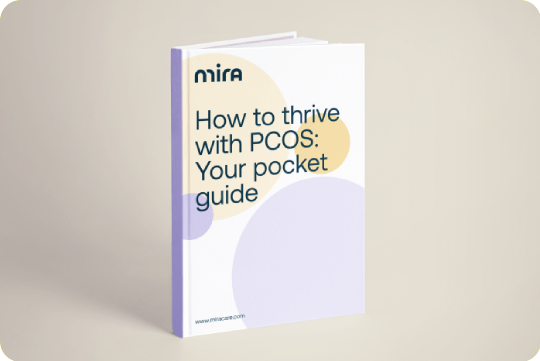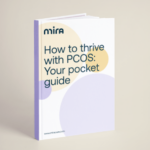PCO vs. PCOS: Understanding the Difference and What Each Means for Your Pregnancy
One of the hallmarks of polycystic ovarian syndrome (PCOS) is polycystic ovaries (PCO) — but what you might not know is that not all women with PCO have PCOS. There is a subtle but important difference between the conditions of PCO and PCOS.

If you are looking to get pregnant with either PCO or PCOS, it’s even more important to understand the nuances of each condition. Each condition can impact your fertility in different ways, as well as your overall health.
What is PCO?
Polycystic ovaries, or PCO, affect 1 in 4 women of reproductive age. Most women with PCO find out during a routine ultrasound, though some may experience mild symptoms. It is considered a common variant of normal ovaries.
PCO are commonly mistaken for PCOS, even though the conditions are different. Studies show that while PCO are a necessary component for the diagnosis of PCOS, women with PCO often lack other features required for diagnosing PCOS.
The primary difference between PCO and PCOS is how it affects female hormones. Research indicates that women with PCO do not quite have PCOS, but do not quite have “normal” hormone levels either. Their hormone measurements lie somewhere between those of “normal” women and those of women with PCOS.
Symptoms
- Some experience irregular periods or ovulation and/or mild pelvic pain.
- However, most experience no symptoms at all.
Diagnosis
PCO is diagnosed via ultrasound. Usually, women with PCO have no symptoms. They go in for an ultrasound, either for pregnancy or another condition, and find out incidentally that they have PCO. Occasionally, they may have irregular periods or ovulation and/or mild pelvic pain, prompting their provider to order an ultrasound to examine the ovaries. Findings of multiple ovarian follicles on ultrasound are suggestive of PCO.
What is PCOS?
Polycystic ovarian syndrome, or PCOS, is less common than PCO, but still highly prevalent. PCOS is diagnosed in approximately 1 in 10 women who go into the gynecologist’s office with complaints. PCO are a component of PCOS, but PCO alone do not indicate PCOS.
Unlike PCO, which are considered a common variant of normal ovaries, PCOS is a metabolic condition characterized by abnormal hormone levels. Women with PCOS have high levels of androgens, or male sex hormones, as well as high levels of estrogen. Resistance to insulin, the hormone that controls blood sugar, is also common in those with PCOS.
Most women with PCOS have symptoms, unlike women with PCO. Some of those symptoms are described in the section that follows.
Symptoms
- Polycystic ovaries (PCO)
- Pelvic pain
- Irregular periods
- Menstrual cycles shorter than 21 days or longer than 35 days, and/or fewer than six menstrual periods per year
- Heavy menstrual flow
- Overweight or obesity
- Insulin resistance
- Excess facial and body hair (hirsutism)
- Acne
- Male pattern baldness
Diagnosis
In order to make a diagnosis of PCOS, two out of three of the following elements must be present:
- Irregular periods. Irregular, infrequent, or prolonged menstrual cycles are the most common sign of PCOS.
- Excess androgens. Abnormally high male sex hormones (androgens) are responsible for symptoms like hirsutism, acne, and overweight.
- Polycystic ovaries. PCO is a sign of PCOS but is not the only element required for a diagnosis of PCOS.
Your doctor may be able to diagnose PCOS on examination if you have obvious signs, such as hirsutism and irregular periods. Sometimes, they may order additional tests, such as hormone tests or an ultrasound to detect PCO.
How do you treat PCO vs. PCOS?
Because PCO is a common variant of normal ovaries, it does not usually require treatment. If you are having other symptoms of PCOS, however, your doctor may recommend one of the following treatment options:
- Hormonal birth control. Hormonal birth control is the first line of treatment for PCOS. Birth control pills combat PCOS by lowering androgen levels, regulating periods, and reducing acne.
- Clomid is an oral medication prescribed to help women with PCOS ovulate regularly. Clomid can help make your periods more predictable and improve your fertility with PCOS.
- Other medications. Some medications are not FDA-approved to treat PCOS but are frequently used off-label to treat it. Examples include spironolactone, an anti-acne drug that reduces androgen levels, and metformin, a medication that improves insulin resistance.
- Weight loss. Many women with PCOS are overweight and/or have insulin resistance, which contributes to a high risk of type II diabetes. Losing a safe amount of bodyweight under your doctor’s supervision may reduce this risk.
Fertility with PCO vs. PCOS
Women with PCO can still get pregnant. Occasionally, the presence of multiple follicles on the ovaries may interfere with the regularity of their menstrual cycle and/or ovulation. As a result, it may be more difficult — but not impossible — to get pregnant.
For women with PCOS, because of the hormonal component of PCOS, getting pregnant may be much harder — yet it is still possible with fertility treatments. As Advanced Fertility puts it, getting pregnant with PCOS is less a question of whether fertility treatment will work, and more a question of which fertility treatment will work.
The first line of treatment for women with PCOS who are trying to conceive (TTC) is a course of Clomid to help them ovulate regularly. Normally, a woman under 35 has a 25% chance of getting pregnant each month; women under 35 with PCOS who are treated with Clomid have a 15% chance of pregnancy each month. Of the women who are able to ovulate on Clomid, about half successfully become pregnant.
If a woman with PCOS fails to become pregnant after one year of treatment with Clomid, she is considered Clomid-resistant. In this case, your doctor might recommend in-vitro fertilization (IVF) treatment to help you conceive. According to one study, approximately 1 in 4 women with PCOS who are resistant to Clomid were able to get pregnant after 60 cycles of IVF.
Tracking Ovulation with PCO vs. PCOS
One reason why getting pregnant with PCOS is more difficult is due to irregular ovulation. If it is more difficult to predict when you will ovulate, it can be more difficult to predict when to have sex in order to get pregnant. Women with PCO sometimes also have irregular cycles, which can make it more difficult to get pregnant. However, this is less common in women with PCO than in women with PCOS.
How Mira can help you get pregnant
Using a digital fertility tracker like Mira can help you determine the exact date of ovulation using the fertility hormone concentrations measured in your urine, the same way an at-home pregnancy test detects pregnancy hormones. It is 99% accurate at predicting ovulation, even in women with irregular cycles due to PCOS.
Many women who are TTC first turn to drugstore ovulation predictor kits (OPKs) to help them predict their ovulation. OPKs detect the LH surge that occurs after ovulation to let you know when you are ovulating. They do this by comparing your LH level to an LH threshold — which can result in false-positive results for women with PCOS, who naturally have high LH.
Women with PCOS have high baseline LH and may get positive results from drugstore OPKs all month long, making it confusing to determine when you are ovulating. Mira, on the other hand, charts your exact hormone concentrations, allowing you to differentiate smaller LH peaks from the LH surge occurring during ovulation for more accurate predictions.
Mira’s Editorial Process
All content produced by Mira meets stringent editorial standards, ensuring excellence and accuracy in language and medical precision. Every piece undergoes thorough fact-checking and review by qualified professionals. Check out our full editorial process to learn more.










